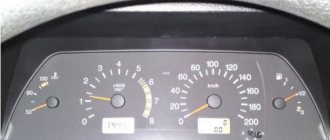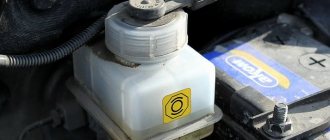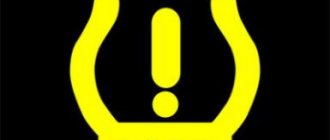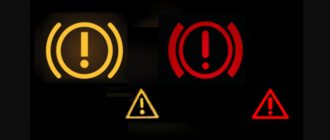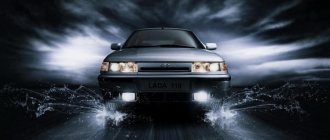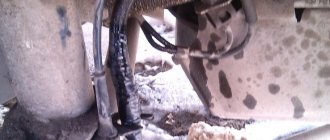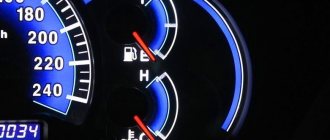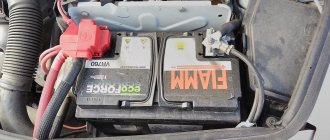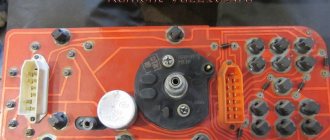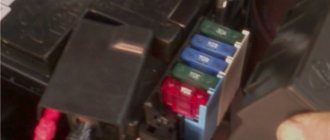Why does the exclamation mark light up on the instrument panel?
At the moment when the car brakes, the brake cylinders are pushed forward as much as possible, thereby acting on the pads.
At this time, the cylinders are filled with the required amount of brake fluid in the system, and its level in the reservoir drops. It is for this reason that a similar exclamation mark lights up on the instrument panel, informing the driver about the minimum level of brake fluid in the reservoir, and accordingly in the system as a whole. If such an indication occurs, first of all we check the sensor itself, which is located in the brake fluid reservoir. It is a float that actively interacts with the brake fluid.
DTUZh is out of order
We looked at the fluid level in the reservoir, made sure that neither the reservoir nor the hoses were leaking, and there were no puddles of brake fluid under the car. We suspect a malfunction of the brake fluid level sensor (BLLS). This sensor is located in the reservoir of the master cylinder (GTC). To check it, you need to turn on the ignition and make sure that the lamp lights up. Then we disconnect the connector from the sensor to de-energize it. If the exclamation mark goes out, then the problem is most likely in the sensor, or rather, in the float, which sinks to the bottom when there is a normal amount of liquid in the container. By the way, the operation of the sensor is checked with a float: press the rubber seal on the lid, forcing the float to fall down. In this case, if the control device is working, the exclamation mark should light up. Conversely, if the sensor is not working, the warning signal will not light. The DTU cannot be repaired. If it is not working, you will have to buy a new one and install it. The price of the part is 150-250 rubles.
After making sure that the sensor is in order, you should check the electrical wiring. That could be the problem too. The wiring is checked as follows: first, the DTSZ is disconnected from the power supply, then they take a copper wire and connect it (close) the sensor power contacts on the wiring, and not in the sensor itself. If the exclamation mark lights up, the problem lies in the wiring. Arm yourself with a multimeter and ring the wires, check the contacts. Or contact an electrician for help.
How to check the brake fluid sensor
In order to check its serviceability, it is necessary, with the engine running, remove it from the tank body and manually change the position of the float. If the indication on the instrument panel does not disappear and does not react in any way depending on the influence on it, then the sensor is faulty and needs to be replaced. However, if the sensor is working properly, there may be a brake fluid leak.
Where might the brake fluid leak?
It is very easy to find out whether the required level of brake fluid is in the system, since it can be seen visually through the brake fluid reservoir. Its level should always be closer to o, and if it is significantly less, or its level has dropped, then a leak is possible.
First of all, inspect the brake cylinders on all wheels for leaks. As a rule, leaks most often occur on the rear drums due to their excessive overheating. It is not difficult to notice a leak on the cylinders, since in the case of the front cylinder, the leaks will be noticeable on the caliper, and on the rear, it can drip directly from the drum. Problems with these elements usually arise during the cold season.
Master brake cylinder
Main cylinder with reservoir: 1 – main cylinder body; 2 – low pressure sealing ring; 3 – drive piston of the “left front-right rear brake” circuit; 4 – spacer ring; 5 – high pressure sealing ring; 6 – pressure spring of the sealing ring; 7 – spring plate; 8 – piston return spring; 9 – washer; 10 – locking screw; 11 – drive piston of the “right front-left rear brake” circuit; 12 – connecting sleeve; 13 – tank; 14 – brake fluid emergency level sensor; A - gap
- When inspecting the brake master cylinder, inspect its external condition for visible leaks.
- The main place where a rupture can occur is the rubber seal located closest to the vacuum booster.
- If a leak occurs, brake fluid will drip onto the gearbox housing and then onto the CV joint on the left side. This is easy to notice, and only then proceed to replace it.
- If you find any of the above elements to be faulty, it must be replaced immediately. Since the operation of the car with such malfunctions is impossible.
- After the brake system element has been replaced, be sure to bleed the brakes, as air will accumulate in the system during the work.
Please note that replacing brake fluid is also necessary because, over time, it accumulates water particles from the air and becomes less effective.
If you find an error, please select a piece of text and press Ctrl+Enter.
The exclamation mark is on: why, what to do?
Many car owners experience situations when an exclamation mark lights up on the instrument panel. On different car models it can be of different shapes and colors - yellow, red, white, in a square, in a circle, in a triangle. But in any case, it means that the car needs to be checked.
It must be said that such a check does not always require a visit to a car service center. In most cases, you can understand why the exclamation mark is on and what is happening to the car on your own.
From this article you will learn:
Removing the torpedo on the old model 2112
To completely remove the device from the car you will need:
- Turn off the on-board power supply.
- Remove the screws around the panel.
- Move the plastic cover of the shield aside and disconnect the wires from the buttons.
- Unscrew the panel fasteners.
- Then the device moves away from its seat and is disconnected from the on-board network.
How the icons on the dashboard work
To understand what is happening with the car, first the car owner needs to understand how the icons on the instrument panel (pictograms) work and how they signal malfunctions.
On different cars, many different icons may be displayed on the instrument panel, informing the driver about the functionality of a particular system. This includes a braking system, an anti-lock braking system, a motion stabilization system, a battery charging system, an airbag system, a tire pressure monitoring system, and auxiliary systems such as cruise control.
Every time you start the engine, all the icons on the instrument panel should light up and go out after a second or two - thereby showing that the bulbs in the icons have not burned out, the icons themselves are operational, and the systems that are monitoring are operational. If, when starting the engine, all the icons go out, but one or two remain on, it means that the system they are monitoring requires checking.
Description of the buttons on the panel
The situation is similar with the control keys for devices and machine components. Even an experienced driver can get lost here. The photo above shows the elements and switches installed in common versions.
| Number in photo | Purpose |
| 10 | Additional equipment control module. |
| 18 | Steering rack position regulator. |
| 19 | Hood lock drive. |
| 20 | Horn button. |
| 22 | Trunk lock actuator button. |
| 24 | Hydrocorrector of headlights. |
| 25 | Switch for turning mode and headlights. |
| 26 | External lighting switch button. |
| 27/31 | Front/rear fog light switch. |
| 33 | Button for turning on the rear window heater. |
| 34 | Instrument lighting regulator. |
| 38 | Exhaust gas recirculation switch. |
| 39 | Air conditioner control buttons. |
| 40 | Heater damper position regulator. |
| 42 | Emergency button. |
| 43 | Switch for wipers and headlight washers. |
What does the exclamation mark mean?
In the vast majority of cars, the "exclamation mark" icon on the instrument panel indicates problems with the car's braking system. Often it lights up in conjunction with an icon indicating the operation of the ABS system and the vehicle stabilization system (if equipped). The appearance of these icons on the driver's instrument panel means that there may be a problem with the brake system and the brakes cannot be trusted.
A malfunction in the car’s braking system is included in the list of faults with which the operation of the car is prohibited by the “Road Rules”. In addition, the driver himself should understand that driving with possibly faulty brakes can lead to the most dire consequences.
If the icon lights up immediately after starting the engine, it is better for the driver to postpone the trip and check the car’s braking system. If the icon lights up while driving, the driver needs to urgently stop and check the brake system.
Note : The "exclamation mark" icon located "inside the tire" indicates low pressure in the vehicle's tires. If it appears on the dashboard, you need to check the tire pressure at the nearest tire shop.
Dial indicators
First, let's look at the indicators with arrows; as we see on the dashboard, there are four of them. Indicator No. 1 shows the temperature of the coolant in the car engine. If the arrow is in the red sector, it is recommended to check the level of antifreeze or other elements of the cooling system (radiator, pump, thermostat). Indicator No. 2 is a tachometer and indicates the rotation speed of the crankshaft of the power unit. Do not rev the engine to maximum power when the needle goes into the red sector, this may negatively affect its durability. Indicator No. 5 – speedometer. Shows the actual speed of the car at which it is moving. Also in this scale there is an electronic display No. 12 - a mileage counter, where the top numbers are the total mileage, the bottom ones are the daily mileage. Well, the last dial indicator No. 6 shows the amount of fuel in the tank. It has a reserve indicator No. 7 with a picture of a gas station; it lights up when the gasoline runs out.
Reasons for the appearance of the icon
The most common cause of a car's brake system malfunction is a drop in brake fluid level. For this reason, on some cars the “exclamation mark” icon may “blink”, depending on driving conditions (the brake fluid splashes in the reservoir, causing its level to become lower or higher).
The fluid level may drop for several reasons, for example: due to a fluid leak, due to severe wear of the brake pads, or due to evaporation during long-term operation without replacement (fluid replacement according to the regulations must be done at least once every two of the year).
Another reason for the appearance of the icon may be a significant decrease in pressure in the brake system, which is created by the vacuum brake booster. In this case, diagnostics of the vacuum amplifier is necessary.
The icon on the instrument panel may also light up if the fault warning system itself is damaged. That is, if the brake system sensor stops working, it informs the driver about it.
The reason for the appearance of the “exclamation mark” icon can also be a malfunction of the hand brake - the parking brake system of the car. For example, the handbrake position sensor may not work correctly, or the handbrake itself may not be completely turned off.
It is worth saying that many modern cars have a built-in computer with extensive capabilities, among which, in addition to setting up vehicle functions and controlling the multimedia system, there is also an express diagnostics section, which displays information about the condition of the car. When any icon appears on the instrument panel, the driver would do well to look into this section, where you can learn about the problem in more detail.
Light indicators on the dashboard of the VAZ 2114
Icons on the instrument panel under No. 3 and No. 4 indicate that the left and right turn signals are on, respectively. Icon No. 8 tells the driver that the side lights and/or exterior lighting are on. If icon No. 9, with an exclamation mark on it, lights up, then there is a problem in the operation of the car’s braking system. In most cases, it may be a low brake fluid level; add fluid to the reservoir. Icon No. 10 on which a headlight is drawn indicates that the high beam headlights are on. Button No. 11 next to the liquid crystal display is used to reset the daily mileage and set the clock. Icon No. 13 lights up when the hazard warning lights are turned on. Indicator No. 14 “CHECK ENGINE" When the engine is running, informs the driver that there is a malfunction in the car’s engine. Liquid crystal display No. 15 – shows the current time and temperature outside the car. Indicator No. 16, which shows the battery, lights up when the ignition is turned on and goes out after the engine starts. If there is a problem with charging the battery. The generator does not work - it may light up or flash. Icon No. 17 P in a red circle indicates that the parking brake (handbrake) is engaged. Indicator No. 18, which shows a red tap, indicates insufficient oil pressure in the engine lubrication system. Low oil pressure can also result from low oil level. Indicator No. 19 indicates the position of the air damper if a carburetor engine is installed on the VAZ 2114.
What to do if the icon appears
The first thing the driver needs to do when the “exclamation mark” icon appears is to postpone his trip (or stop if the icon appears while driving).
Then you need to try to understand why the icon appeared. To do this you need:
- Go to the “car status information” section of the on-board computer (if there is one) and find there the reason for the appearance of the icon;
- Check the brake fluid level in the reservoir under the hood and add fluid if necessary;
- Check the connector of the brake fluid level sensor (remove and clean), it happens that dirt gets under the connector casing or brake fluid fills it;
- Check the position of the handbrake and its limit switch, tighten and release the handbrake several times;
- Check the condition of the brake pads (if the wheels allow this); excessive wear on the pads may be the cause of a low brake fluid level;
- Check the operation of the brakes by pressing the pedal (if it is very soft or very tight, it is better not to drive the car again until the problem is eliminated);
- If you can’t independently determine the reason for the appearance of the “exclamation mark” icon, it is better to call a tow truck and take the car to a car service center, or try to find a good on-call diagnostician;
- If the nearest car service center is far away and there are no diagnostic specialists, you can try to read the errors yourself through the car’s diagnostic connector, via a special Bluetooth or Wi-fi adapter. For example, the ELM-327 adapter is very convenient and popular, which can be ordered with home delivery;
If two icons are lit, “exclamation mark” and ABS
This often happens when two icons light up on the instrument panel at once, for example, an “exclamation mark” and an ABS icon (or a stabilization system icon in the form of a “car on a crooked path”).
Since the car’s braking system is often very closely connected with the ABS system (Anti-lock Braking System) and the motion stabilization system, if a malfunction occurs in one of these systems, the second may also stop working and/or be forced to turn off on-board computer. Therefore, if two icons appear on the instrument panel at once, you will have to look for a fault in two systems at once.
A ringing voice flies into the distance
VAZ 2112 2001, please explain how the low brake fluid level lamp (exclamation mark on the instrument panel) is connected to the starter and ignition switch.
I cleaned all the wires and contacts, it didn’t help, I can start it with a screwdriver... What nonsense, red yellow, handbrake, sorcerer asks to go somewhere, this is a VAZ 2110. This icon means that the brake fluid level is low or there is something wrong with the sensor itself. The symbols on the instrument panels on all VAZs are almost the same, just the location is different.
There were similar things - it came on when braking, went out periodically... in short, it didn’t stay on all the time. Rashit is right! This is what I do on mine - the low brake warning light starts to turn on periodically - I change the pads. The liquid rises to the maximum level.
It also happens that brake hoses “swell” due to age, and the volume of brake fluid “leakage” also moves further away from the normal level. Before starting the engine, it lights up constantly to check the health of the light bulb, if I'm not mistaken. A friend’s Check Engine light was on on a VAZ 2112 1.6 16 valve. it was on and off.
The lock is in two positions only? jammed? Maybe there is air left and when you press the brakes the level goes away. 2110 (or rather, maybe he only knows the VAZ 2110, but very poorly). If it refuses to light up when you crank the starter and the handbrake is raised, then this is a jamb. If this is the case, then most likely the problem is in the “crooked” installation of the alarm with auto-start.
The VAZ 2112 instrument panel does not work - reasons
If the panel suddenly stops working:
- When the engine does not start and the dash does not work, inspect the ignition switch. Here the contact often burns out or oxidizes.
- If the machine is working and the panel has failed, you will need to check the corresponding fuse, wiring and lines.
- If the manipulations do not help, you will need to remove the device and test its circuits.
Panel backlight does not light up
There may be damage to the light activation key. It is recommended to check the corresponding fuse.
The panel is blinking
Consequence of deterioration of electrical wiring contacts. The user should inspect the supply wires for cracking or damaged insulation. The contact groups should be disconnected and cleaned of oxides and dirt. Treat the terminals with special oil.
Tidy 2112 stuck
This kind of problem is unexpected, but it occurs everywhere. As a repair, users are suggested to reset the electronic equipment. Remove the terminals from the battery and wait 15 minutes.
In this case, you need to check the light bulb itself (burnt out), or the handbrake lever
We need to figure out what we are talking about. It seems like we are talking about different things: 1) The “low brake” light has nothing to do with the position of the handbrake. Many car enthusiasts are faced with this seemingly simple question.
1 — Coolant temperature, in degrees Celsius. 8 - Indicator lamp for turning on the dimensions. 13 - Hazard warning lamp - “hazard light”. 14 - Check Engine, often indicated by this icon - this means a malfunction in the engine, it is recommended to stop the engine.
This sign indicates insufficient brake fluid level. The ignition switch assembly looks like the key has three positions: 1) All electrics are on, 2) that is, just turned off, and 3) turning on the starter. If the handbrake is tightened, the light ((P)) is on. In general, the exclamation mark is the brake fluid or the brake pad wear sensor, some do not turn it off.
